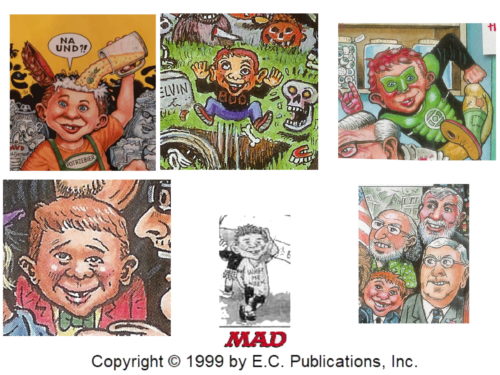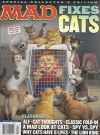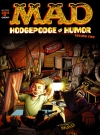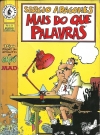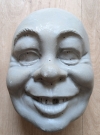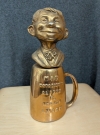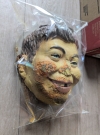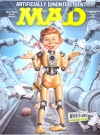Article by Dave Robinson (writer-illustrator, British MAD 1978-94)
Alfred E. Neuman – ‘The What-Me-Worry Kid’ – Introduction
1950s MAD Editor Harvey Kurtzman was in the editor’s office at Ballantine Books when his gaze swept the office bulletin board and rested on a pinned-up postcard bearing the idiosyncratic head and shoulders of a boy who, given time, would evolve into MAD’s cover boy.
Kurtzman had probably seen the face, before: similar-looking youths had been appearing since before 1900, in ads for painless dentistry – along with his ‘What, me worry?’ catchphrase — and, on 1930s presidential campaign postcards proclaiming ‘Sure I’m for Roosevelt’ (meant in a negative way) – and several more.
The lad graduated to the front cover of ‘The Mad Reader’ paperback collection of reprints from previous issues of the MAD comic book (1954); and, the following year, made the regular issue’s cover as a rubber mask labelled ‘idiot’, albeit tiny and crammed among a plethora of ad spoofs (#21). When MAD switched to magazine format with #24, the face appeared at the top of the ornate, archaic-looking border around the covers, realised by the team of Kurtzman and long-time collaborator Bill Elder.
By 1956, while the character had already appeared in color in a Jack Davis crowd scene on the cover of MAD #27, MAD’s second editor Al Feldstein wanted a mascot for the magazine and sought a quality artist to capture the boy’s knowing, ironic, gap-toothed grin, forever aimed at his audience. Norman Mingo, an established magazine illustrator, answered Al’s ad in The New York Times and was initially affronted when he learned that the ‘national magazine’ in question was MAD.
Feldstein proved persuasive, though, and the resulting portrait, which debuted with the label ‘write-in candidate for President’ on the cover of MAD #30, has become the prototype for all subsequent Neumans associated with MAD (a similarly-standard rear view of Neuman’s head adorned the back cover). Neuman has appeared in one form or another on the cover of nearly every issue of MAD, spin-off publications and related artefacts. Moreover, Alf’s tilt at the Presidential windmill has been sustained each time an election occurs.
The character had already suffered an undisciplined plethora of fictitious names at MAD, including Melvin Coznowski or Cowsnofsky, Melvin Sturdley, Mel Haney and more, before settling. Alfred L. Neuman had been used elsewhere in the magazine, borrowed from film composer Alfred Newman – via Henry Morgan’s comedy radio show — to represent an ineffectual moniker: it was Production head John Putnam who switched the L to an E. MAD also picked up Neuman’s catch-phrase, ‘What, me worry?’ trying various punctuations.
Alfred E. Neuman’s exact origin is no longer clear. When an artist’s widow sued in 1965 for copyright infringement, claiming that her late husband had created the character, MAD was able to drag up a selection of like images which dated back to 1911 and so preceded hers; but even earlier examples have since been located, including an advert for ‘Atmore’s Mince Meat, Genuine English Plum Pudding’ (1895) and another for a comedy stage play, ‘The New Boy’ (1894). Some schools of thought suggest that Alfred stems from more than one source; others that a playful graffiti artist perhaps blacked out a tooth on one poster, causing the gap to be forever associated with the boy’s image. Whatever the truth, the lawsuit rather had the opposite effect from that intended, as the boy’s face and phrase have now become almost permanently associated with Mad.
Neuman has appeared only occasionally inside the magazine’s articles; and with a few rule-proving exceptions, Neuman portraits have generally conformed to front or rear views, including some in silhouette. One reader claimed that Alf had a ‘one-dimensional head’. A female version of Neuman, named ‘Moxie Cowznofski’, her forename inspired by a soft drink of the 1950s, has appeared sporadically since the 1950s.
Over the decades, the Alfred E. Neuman face and ‘What, me worry?’ phrase have frequently been referenced by broad media, as shorthand for inexplicable idiocy. It is therefore less than flattering that, from 1958, readers have attested to Alfred’s resemblance to a slew of high-profile figures, beginning with Charles, now Prince of Wales and heir to the British throne: a protest letter received on authentic Buckingham Palace stationery has since been clumsily lost. Others tarred with the Neuman likeness have included Ted Koppel, Oliver North, David Letterman, singer Rick Astley and British Prime Minister Boris Johnson (after morphing).
Despite Al Feldstein’s wish that Alfred should always look the same, with that identical expression, sundry artists over the years have taken liberties with Neuman’s appearance, attire and mood – as we shall now see…
Day 1 – Harvey Kurtzman and Will Elder
In October 2019, a fan wrote to the MAD Magazine and Alfred E. Neumam Collectors’ Facebook group: ‘Does a picture/drawing/collage exist of all the interpretations of Alfred E. Neuman done by various artists from the UGOI?’ Fairly confident that no such collection exists, I began some research of my own. The results are fairly copious, so I decided to present these an artist (or two) at a time.
Earliest were, not surprisingly, Harvey Kurtzman and Will (Bill) Elder who, as many know, came ‘bolted together’, with Elder realising HK’s painstaking visual concepts.
Neuman (not yet named) appeared in cover borders from the first magazine issue of MAD (#24, 1955).
Elder’s ‘Alfie’ award was reused at least once in an article by another artist (Mort Drucker), then restyled by other artists as MAD progressed.
As ‘WEHK’, the pair returned to MAD in 1985, including three covers over the following few years.

Day 2 – Jack Davis
JACK DAVIS drew fast, with quality, making him allegedly the first millionaire cartoonist. Some fans see Jack as a regular cover artist, although he drew no more than a dozen MAD covers, including the Neumans on the front of #27 and on the back of #30.
The variance in the monochrome Neumans below provides a good example of why editor Al Feldstein requested a ‘settled’ Neuman image in 1956, after which Jack’s AEN heads conformed more closely to the Mingo prototype…
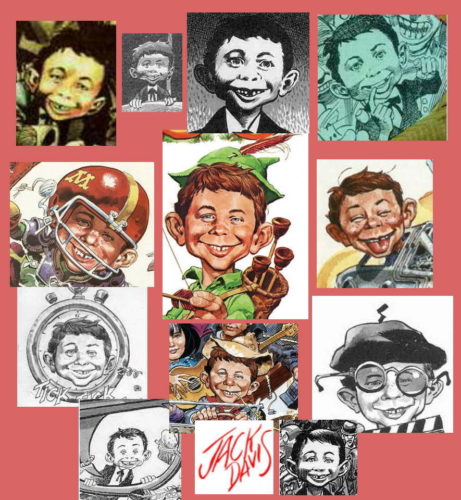
Day 3 – Wallace Wood
WALLACE WOOD allegedly led a troubled life which ended tragically in 1981: while this made him hard for editors to manage in terms of meeting art deadlines, it affected neither his quality (for me, one of MAD’s top three) nor his detailed quantity of content over the early years of MAD magazine.
His version of Neuman flexed to meet each challenge, as seen below.
One British MAD editor felt that Wood ‘couldn’t draw Alfred…’, but he was used to the Mingo colour version, while Wally’s monochrome variations were closer to Neuman’s predecessors.
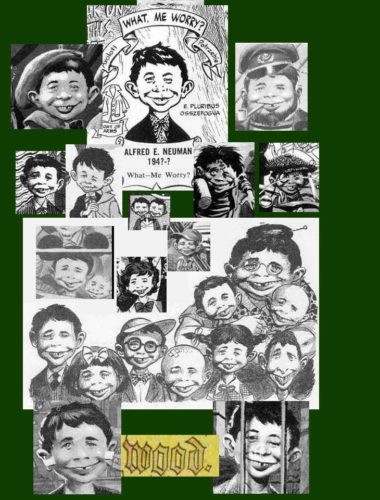
Day 4 – Al Jaffee
AL JAFFEE returned cap-in-hand to MAD in the new Al Feldstein era, after leaving to work on Harvey Kurtzman-led projects, to be accepted immediately by Bill Gaines on the strength of that work.
It is surprising how much writing Jaffee did for Feldstein (work of quality, possibly due to the fact that Al could think ‘visually’) until the editors concluded that Jaffee’s roughs were often funnier-looking than the finished job by another artist.
Al’s Neumans often conformed to the Mingo prototype, including the ‘wordy’ cover which is included here because of Jaffee’s clever use of an overlay to achieve the desired effect.
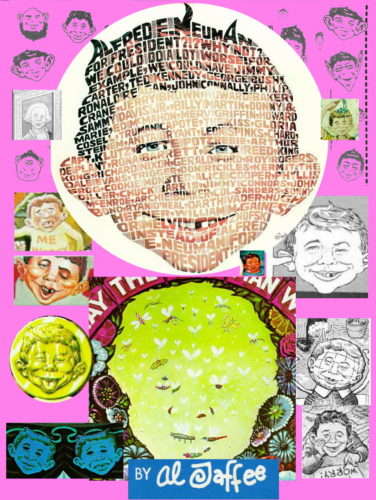
Day 5 – Don Martin
Apologies, Don Martin fans, but this back view from a 1974 cover (#165) was the closest ‘MAD’s Maddest Artist’ got to drawing Alfred.
Martin covers generally had the Norman Mingo AEN head in facsimile, alongside the MAD logo.

Day 6 – Bob Clarke
Robert (Bob) Clarke‘s work was clean and professional. His background in advertising enabled Bob to handle broader art chores which were less suited to those with more specialist skills. Clarke’s version of Neuman was close to the Mingo original and – as shown here – Bob was versatile and prolific…
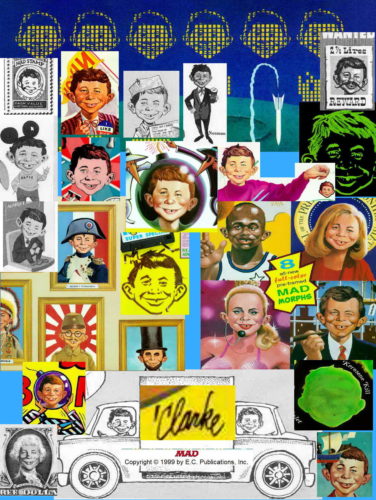
Day 7 – Norman Mingo
While ‘purists’ may choose otherwise, some see NORMAN MINGO as the definitive MAD cover artist. Mingo was versed in magazine illustration before coming to MAD, and his early MAD covers look almost like spoofs of ‘that type’ of magazine cover.
Mingo was initially disgruntled when he learned that it was MAD whose ad he had responded to. Nonetheless, commissioned by Al Feldstein to paint the iconic AEN in colour, Norman came up with the goods and adhered faithfully to his depiction more or less throughout, while sometimes adding spectacles here, or a mustache there.
Tempted away after his first 8 covers, Norman was later lured back for a longer stint.
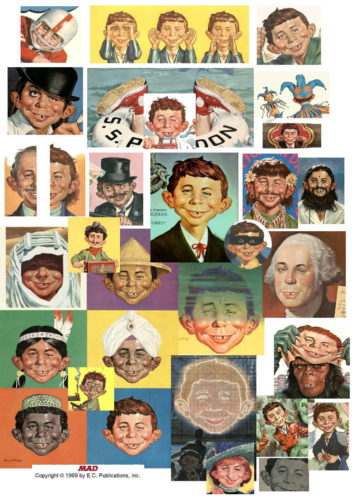
Day 8 – Mort Drucker
Depending on when they began reading MAD, some followers see MORT DRUCKER as a regular MAD cover artist, based on more than two dozen quality frontal contributions with classics including Hulk-a-Mania, The Simpsons, Home Alone and Wild, Wild West.
Others regard Mort primarily as an internal MAD artist, due to the strength of his history of monochrome (and other) work inside the magazine. These latter fans might be surprised to be reminded that Drucker contributed more covers than both Freas and Rickard.
Quite simply, a one-off.
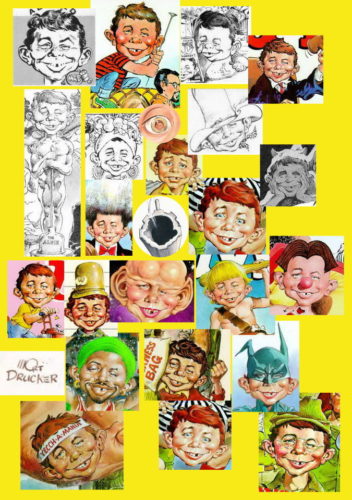
Day 9 – Basil Wolverton
From 1957, issue # 31, BASIL WOLVERTON’s ‘spaghetti-and-meatballs’ look, seemingly tailor-made for MAD, was ironically not publisher Bill Gaines’s favourite. Wolverton’s style was almost inimitable, the rule-proving exception being his son Monte, who also worked for MAD.
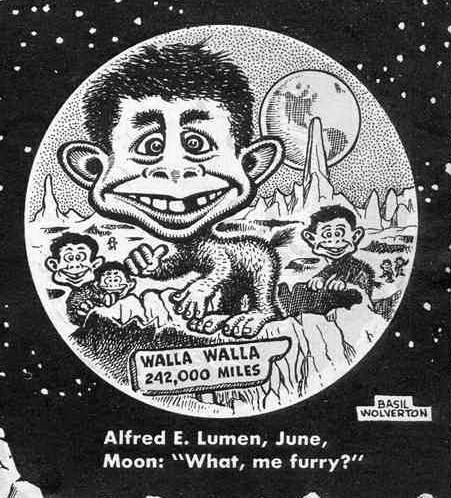
Day 10 – George Woodbridge
George Woodbridge did not consider himself a cartoonist, versed as he was in depicting ‘serious’ subjects like accurate portrayals of military uniforms, etc.
Nonetheless, George developed a useful MAD style, including a sometimes ‘somewhat seedy’ look for articles penned by Frank Jacobs, Tom Koch’s legendary ‘43-Man Squamish’ and more.
Woodbridge drew only one cover for MAD Magazine proper, the other colour versions coming from Specials and paperbacks…

Day 11 – Dave Berg
DAVE BERG didn’t draw any covers for the regular magazine (the colour AENs here are from the fronts of Dave’s paperbacks). Later readers tend to underrate Berg as a writer-artist for MAD, possibly because he’s judged by his prolific ‘Lighter Side’ feature. Nonetheless, this belies the excellent earlier work he did for MAD (and others), helping to shape the magazine’s humour.
When it came to Neuman, if Dave needed to show AEN on a poster or similar, he usually ‘toed the line’ and pasted in a Mingo version.
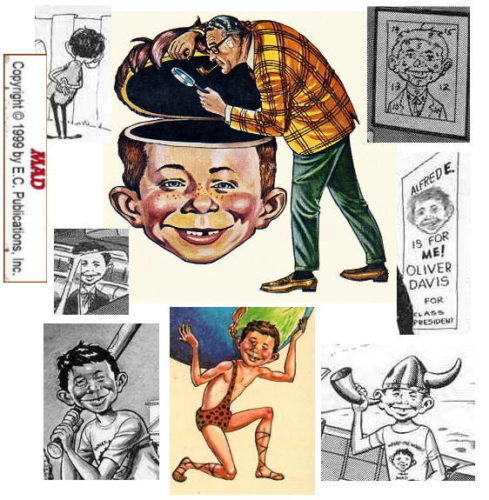
Day 12 – Joe Orlando
Italian-born JOE ORLANDO initially assisted Wally Wood, graduating to EC and MAD as an illustrator. After leaving MAD, he fast-tracked in sundry roles including editing, and became Associate Editor with MAD after the death of his friend Bill Gaines.
In 1997 employees at DC on Broadway were devastated to learn that Joe had passed away at Grand Central Station on his way to the office.
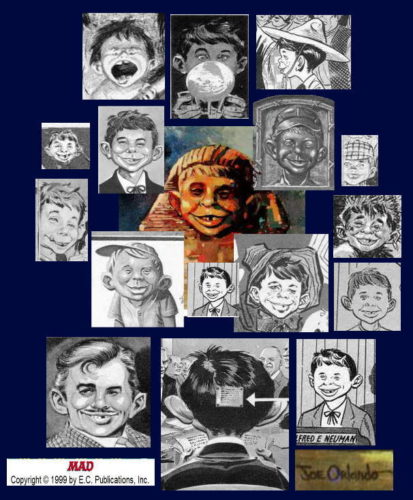
Day 12+ – John Putnam
JOHN PUTNAM’s slightly-chequered career at MAD began in the EC era under the broad heading of ‘Production’, causing a cynical Bill Gaines to enquire ‘What does he do?’
Putnam was hurt when Harvey Kurtzman quit MAD, but did not include John among the individuals he took with him; and was further nonplussed when publisher Gaines suspected John of being a mischief-making ‘Phantom’.
All of this belies JP’s loyalty and contribution to MAD for the remainder of his life, including a professional knowledge of typefaces which enhanced MAD’s ad spoofs and more; and an off-the-wall sense of humour which contributed to the overall MAD ethos. Promoted to Art Director, Putnam would step in when a straightforward graphic was required, as here.
John Putnam passed away in 1980 in a German hospital, having been taken ill on one of the legendary MAD trips.
[There is no day 13, due to Gaines’ superstition]
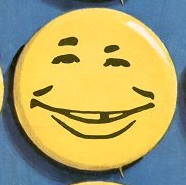
Day 14 – Frank Kelly Freas
Fans tend to regard as definitive the cover artist who was in place at the time they began reading MAD: this is particularly true of followers of FRANK KELLY FREAS (their nearest chauvinistic rivals being aficionados of Kurtzman’s MAD).
Freas was almost unique among regular cover artists in that he helped devise the cover gags, with an atmospheric sense of irony that helped to shape the magazine’s approach, and which has been emulated only rarely since his departure from MAD (if at all, by Freas himself or anyone else).
It is likely that Al Feldstein found Freas tricky to manage, as FKF tended to ‘flex’ the Neuman look as suggested by each gag — a departure from the adherence to Mingo’s AEN, preferred by Al.
As Freas left MAD, he claimed that Neuman was ‘making him stale’, although it never truly showed. In truth, the artist relocated to Mexico c1962, heralding the end of his tenure…
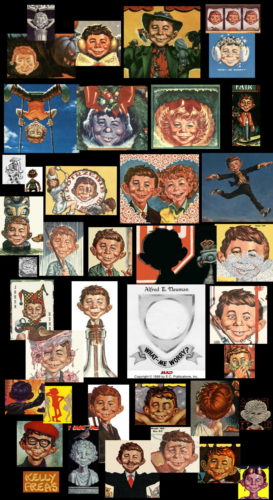
Day 15 – Lester Krauss
Early resident photographer LESTER KRAUSS did memorable work on MAD’s inside cover ads, etc. These lie at odds with this laid-back MAD cover idea from Xmas 1969 (dated Jan 1970), included here for completeness.
Krauss has tended to be underrated in favour of the work of successors like Irving Schild.
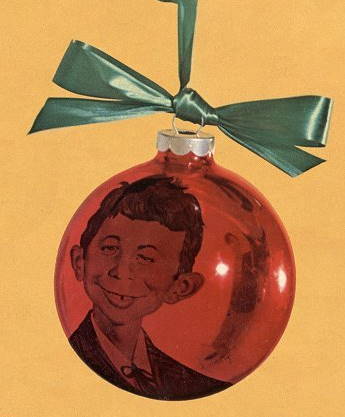
Day 16 – Antonio Prohias
ANTONIO PROHIAS was a recognised political cartoonist in Fidel Castro’s Cuba – so well recognised that he felt obliged to quit for New York, where he was reduced to toiling in a garment factory until touting his portfolio to MAD, with his daughter acting as interpreter.
His regular Spy vs. Spy feature filled a niche in Al Feldstein’s burgeoning new-style MAD, and paperback compilations flourished to rival those of Don Martin. Despite all this, Antonio regrettably managed to draw only one Alfred E. Neuman along the way.
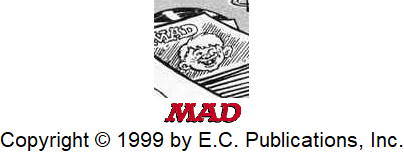
Day 17 – Paul Coker Jr.
PAUL COKER JR worked on greetings cards before coming to MAD, a style to which his thick-thin line (actually labour-intensive) was well-suited; among others, Paul designed a flexible character for Hallmark who could be seen as either male or female.
Coker was teamed with writer Phil Hahn when he came to MAD (before Hahn moved on to write TV scripts and more on the west coast).
Paul’s cover work for MAD has been limited to the short-lived yellow-border series, paperbacks and one special.

Day 18 – Jack Rickard
JACK RICKARD‘s work had ‘sparkle’, and some MAD readers familiar with his colour covers may be unaware that Jack initially drew grey-tone articles inside the magazine.
On at least one occasion, Jack was assigned to produce a MAD front cover spoofing a movie poster he himself had painted.
Jack’s originals were sometimes even better than the printed job, observed the late Nick Meglin who added that, professionally, of all the talents that had sadly passed, MAD perhaps missed Jack’s work the most – praise indeed.
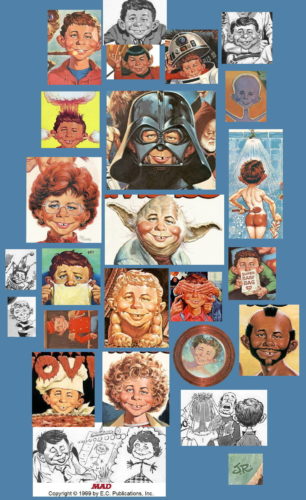
Day 19 – Duck Edwing
For a lot of years, DON ‘DUCK’ EDWING provided riotous ideas for MAD – sometimes credited, sometimes not – on which other artists like Don Martin ‘dined out’ (this is no criticism of Martin, whose renditions were usually impeccable: one British MAD editor pointed out, with a degree of justification, that an extreme Edwing gag appeared ‘less sick’ when drawn by the other Don).
Despite creating cover ideas for the regular magazine, The Duck had an off-the-wall art style (at one point, the eds experimented with Harry North inking Edwing’s pencils) that was never aired on covers — except on MAD paperbacks, for several of which he packaged the entire job: script, art and covers.
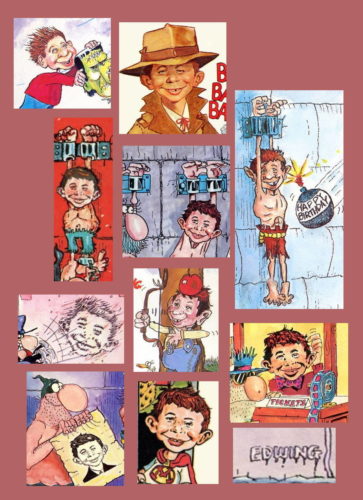
Day 20 – Sergio Aragonés
Hispanic cartoonist SERGIO ARAGONES came to MAD via Mexico, where he was brought up. Serge’s first sale to MAD was a look at the US Space Effort (1963) which has rarely been bettered, possibly because of the ‘newness’ of the Sergio humour at that time.
Aragones manages to produce hilarity, lightning-fast, including eye-straining crowd scenes. His microscopic marginal cartoons long ago replaced the text-based, though clever, original marginals which editors were finding a chore.
Sergio’s work extends beyond cartooning: his MAD cover ideas exceed the number of covers he has worked on as an artist; furthermore, his work on Groo the Warrior, etc., for DC and others, has given Sergio a life and fan-base beyond MAD.
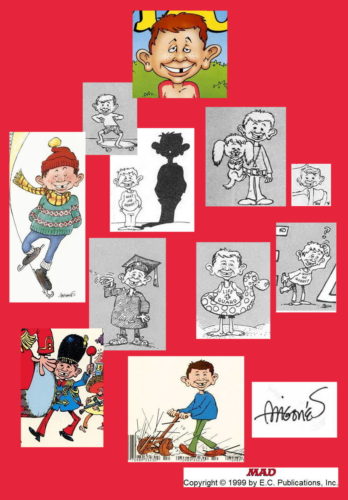
Day 21 – Irving Schild
Included for completeness, this look at the work of MAD resident photographer IRVING SCHILD includes a nod to pumpkin sculptor HUGH MCMAHON.
Schild was with MAD for a number of years, his creativity in setting up shots being more usually confined to MAD’s ad parodies.

Day 22 – Paul Peter Porges
As well as his work in MAD, PAUL PETER PORGES had cartoon work in The New Yorker, the Saturday Evening Post and more.
Vienna-born Porges came to the USA via France and Switzerland during WW2.
Paperback covers by PPP tend to use the Mingo ‘house’ version of the Neuman visage – with this exception (MAD Around the World, 1979).
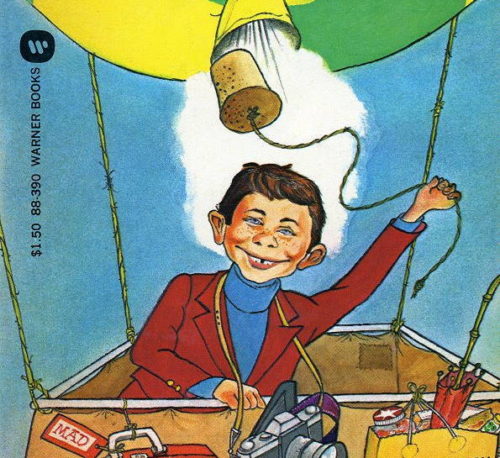
Day 23 – Max Brandel
Often politically slanted, MAX BRANDEL‘s sojourn with MAD (1966-78) was underrated and all-too-short, his ability to ‘think visually’ being epitomised by this composite Neuman physiognomy, comprising a selection of erstwhile candidates.
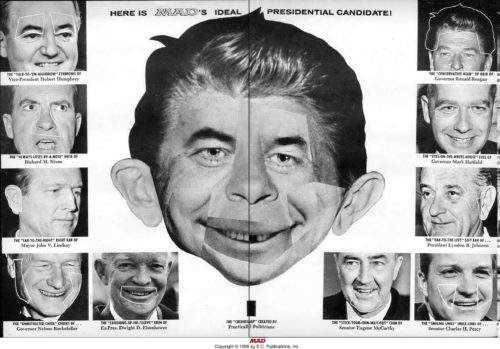
Day 24 – Angelo Torres
The photographic clarity achieved by ANGELO TORRES in his art is arguably unrivalled in MAD. The Puerto Rican was comparatively late joining MAD’s core talent pool, having formerly auditioned only partly-successfully with EC comics.
Angelo ventured on to MAD’s regular covers, only in the margins of the controversial ‘yellow border’ series.
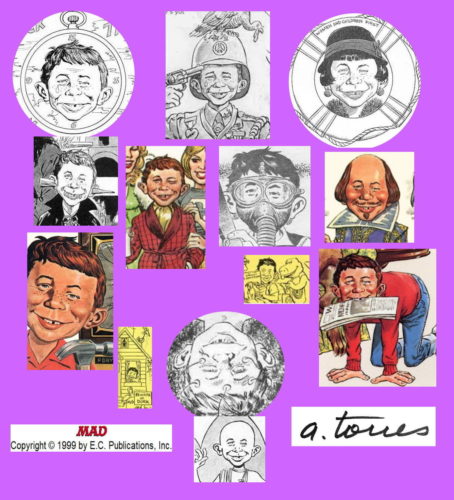
Day 25 – Arnoldo Franchioni
Argentine artist-writer ARNOLDO FRANCHIONI worked for MAD imitators Cracked and Sick, as well as contributing his often-political work to MAD from 1972-79, enhancing his linework with photographs as (kind of) shown here (1975, #176).
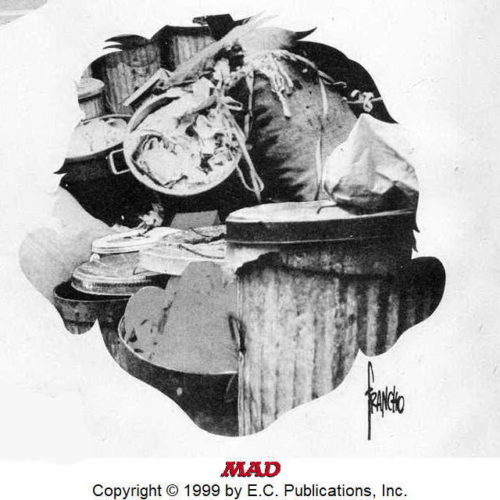
Day 26 – Mort Künstler
From 1976: MUNZ (MORT KÜNSTLER, also listed as Kuntzler) provided one back cover for MAD also, as well as this front which many readers regard as iconic.

Day 27 – Harry North
If you recognise only a quarter of this HARRY NORTH (Esq.) selection, it’s because the remaining 75% wasn’t drawn for American MAD! Harry is unique in contributing original material to both the parent magazine and his home British version (although North later relocated to New York).
HN came to MAD from British comics, where his talents were wasted as a ‘bodger’, literally drawing points on word balloons; and via Rene Goscinny’s ‘Pilote’, after interest had been shown by John Putnam and others.
Note Harry’s unique 3-D view of Alfred, with Bill Gaines, from a 25-year celebratory issue of British MAD.
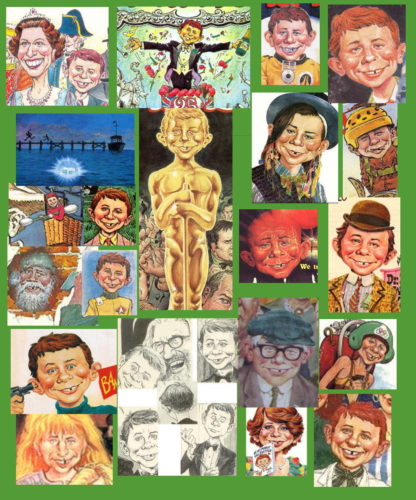
Day 28 – Bob Jones
Bob Jones’s try-out as MAD cover artist was comparatively short-lived; nonetheless, had Jones continued at MAD, it wouldn’t have surprised us.
His attempts at Alfred, here, vary between Mingo-orientated and his own idiosyncratic version.
Beyond MAD, if Bob had only ever drawn his classic ‘Tiger in your Tank’ for Exxon (ably spoofed for MAD by Bob Clarke), this would have been enough.
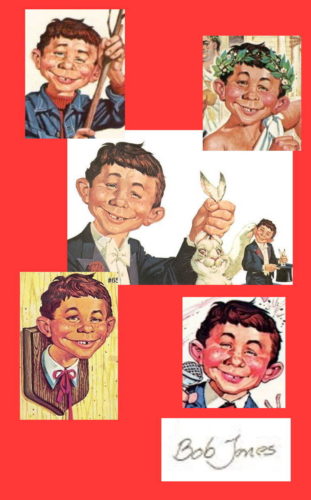
Day 29 – John Caldwell
When JOHN CALDWELL paid an early visit to MAD’s New York offices, he was awestruck when encountering MAD boss Bill Gaines in the men’s room. This did not prevent John from drawing his singularly-styled cartoons for Playboy, the New Yorker, the Wall Street Journal, Reader’s Digest, National Lampoon, recycled greetings cards and more, including becoming one of MAD’s best-loved cartoonists.
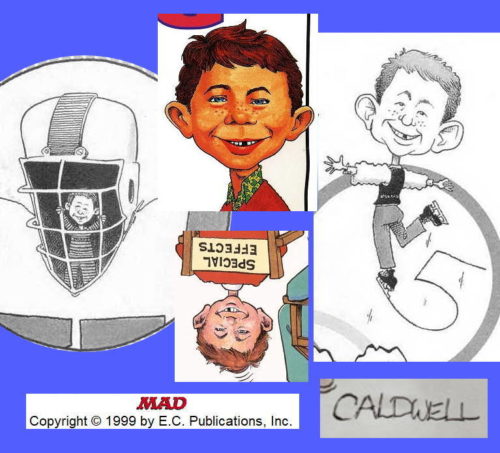
Day 30 – Sam Viviano
Of all the MAD caricature artists who came ‘in the wake of’ Mort Drucker, SAM VIVIANO is probably the one who retained his idiosyncratic ‘edge’, the most. Along the way, Joe just happened to be promoted to VP at MAD for Art and Design!
Under his Jack Syracuse nom de plume, Joe also produced exaggerated phot-collages of celebs.

Day 31 – Richard Williams
There was a Rockwellian tone to the work of RICHARD WILLIAMS (not the Roger Rabbit animator, although the combination might have been interesting!).
While MAD’s third most prolific regular cover illustrator may have lacked the sparkle of Rickard or the irony of Freas, dependent on the time readers came on board, some will doubtless regard RW’s work as definitive.
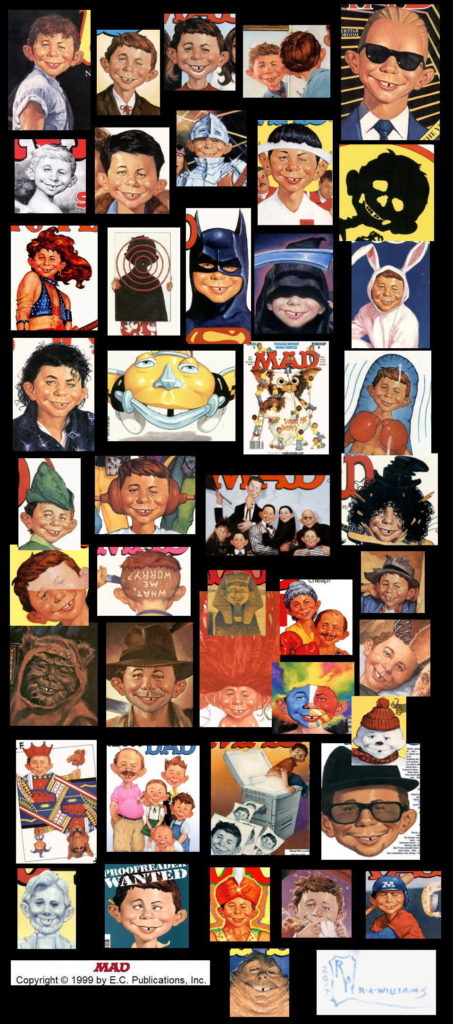
Day 32 – James Warhola
Most people automatically regard Andy Warhol’s work as iconic, but some MAD fans may be surprised to learn that JAMES WARHOLA is Andy’s nephew.
Even though ‘combination’ MAD covers traditionally fail to sell well, Warhola’s ‘knife and fork’ Rambo-Dundee cover of 1988 is arguably close to the work of the late, great Frank Kelly Freas.
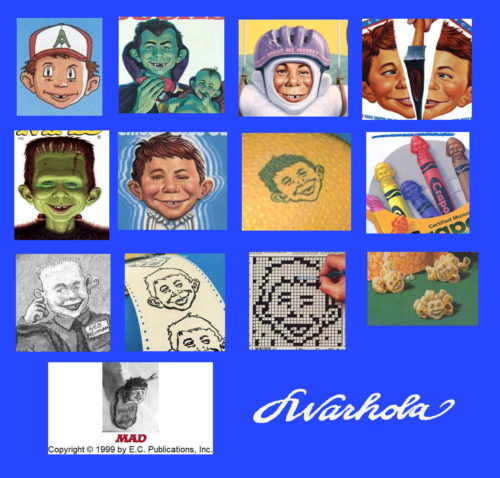
Day 33 – Tom Hachtman
TOM HACHTMAN lent his singular style of writing and art to a dozen MAD items over 13 years from 1984.
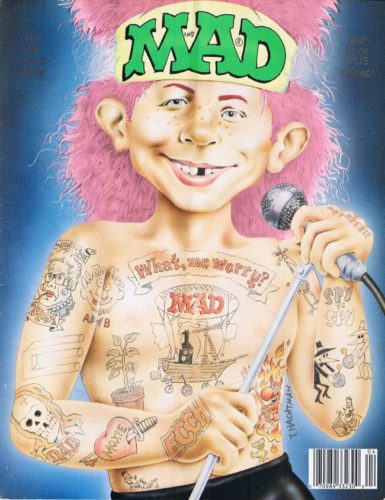
Day 34 – Doug Webb aka Armanli
DOUG WEBB, aka ARMANLI, managed two covers for MAD in the mid-1980s, including one for the ‘QWERTY MAD’ paperback. His regular cover, where a helicopter uses a large Q-Tip to attend to Liberty’s ears, was translated by Ron Letchford and Harry North for the British MAD version some time later, in which London’s Nelson’s Column was addressed from a hot air balloon.
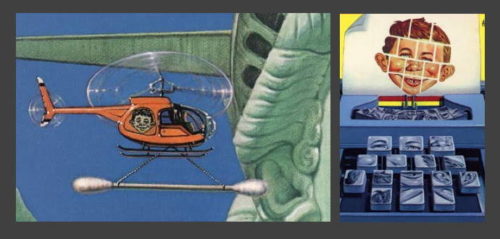
Day 35 – Rick Tulka
Brooklyn-born RICK TULKA honed his neat, ‘cute’ caricatures of pop and rock stars at MAD before decamping with his wife for Paris in 1995. Either side of this, Rick drew for The Wall Street Journal, Reader’s Digest, Rolling Stone and more in the US; plus French titles including the ill-fated Charlie-Hebdo, also participating in the Peaceful demonstrations in support of the journalists.
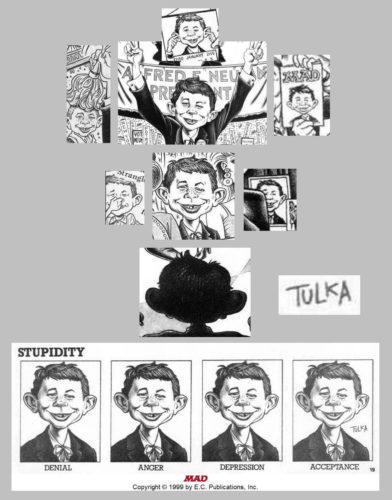
Day 36 – Greg Theakston
For ten years, Earl P. Wooten was one of MAD’s successful back cover artists, working under his more recognisable name, GREG THEAKSTON! He drew for several top comics publishers, working with icons including Starlin, Adams, Kirby and more. Greg was a long-time achiever in comic fandom, and was an award-winner in 2010 for carrying forward the comics ‘torch’. His important ‘Theakstonizing’ process bleached color from old comics pages, ready for reprinting. Sadly, Greg passed in 2019.
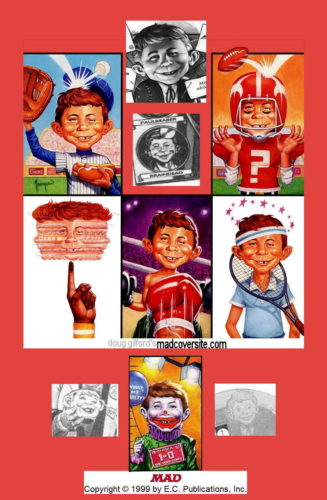
Day 37 – John Pound
Though it leans heavily on the stock MAD black-and-white AEN image, this 1991 image by JOHN POUND is included for completeness.
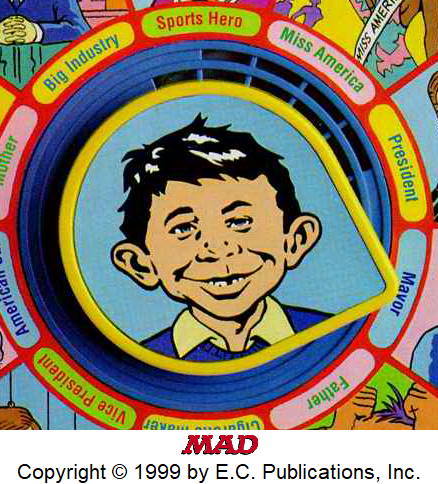
Day 38 – C.F. Payne
Chris Fox Payne, better known to MAD fans as C.F. PAYNE, was among a smattering of artists who painted MAD covers in the years between Williams and Fredrickson. CFP has also worked for Time, Sports Illustrated, Rolling Stone, National Geographic, Spy and more.
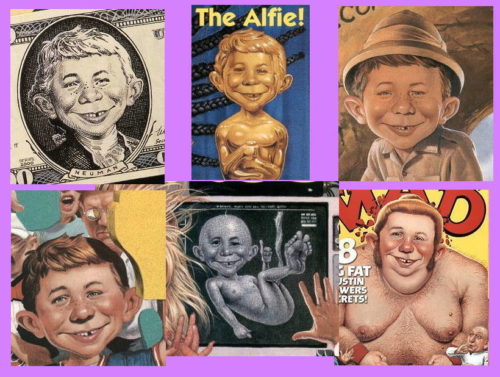
Day 39 – Drew Friedman
DREW FRIEDMAN, award-winning son of satirist Bruce Jay Friedman, studied under Eisner, Kurtzman, Spiegelman, Roth and others before working for a number of name titles. While the style of one or two artists sits not-quite-comfortably within the pages of MAD, Friedman is the opposite: his approach is tailor-made for MAD, underpinned by his work-intensive ‘stippling’ technique and a sound cultural interest and expertise.
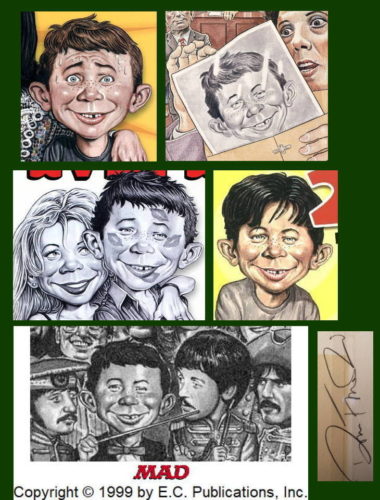
Day 40 – Mark Fredrickson
This guy’s ‘done a couple’: while some long-time readers may underrate more recent MAD arrivals, MARK FREDRICKSON has created more MAD covers even than Mingo and Williams. In an IT-driven era, Mark is among MAD’s most technically adept artists, in a field where there are few slouches. His non-MAD art is also exceptional.
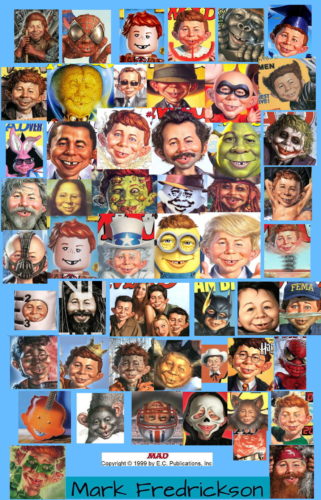
Day 41 – James Bennett
From the mid-90s, MAD tried out a number of front cover artists. Here are five of the most capable, beginning with JAMES BENNETT.
Pennsylvania-based, Bennett has a conceptually humorous style seen in work for The New York Times, Sports Illustrated, TIME, RCA Records, Paramount Pictures and more. He has illustrated books by Carl Reiner, Jerry Seinfeld, Mel Brooks and others, including best-sellers.
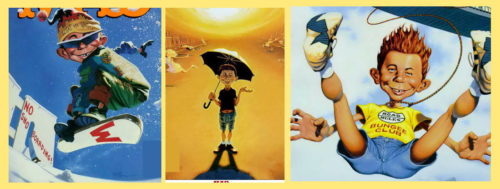
Day 42 – Joe DeVito
Born in New York’s Hell’s Kitchen and raised in New Jersey, JOE DEVITO is multi-disciplined, working as artist, sculptor, author and more on pop culture figures such as King Kong, Tarzan, Superman, Batman, Wonder Woman and Spider-Man, as well as Alfred, in multiple fields including books, magazines, posters, trading cards, film and TV.

Day 43 – Hermann Mejia
Venezuelan-American painter-sculptor HERMANN MEJÍA, now based in Brooklyn, helps sustain the continuing international flavour among MAD’s staff and UGOI. Showing contemporary art influences, Mejia’s MAD style falls beyond MAD’s usual, Drucker-influenced school for continuity art.
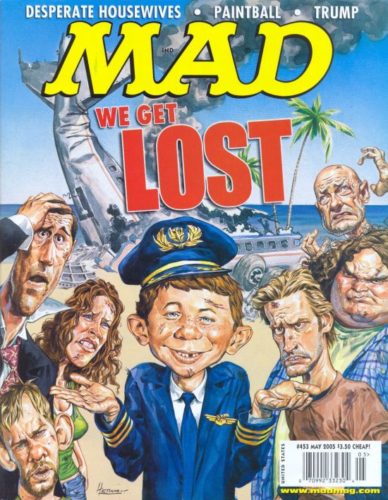
Day 44 – Roberto Parada
In addition to MAD, ROBERTO PARADA’s painterly style and striking likenesses have appeared on, and in, Time, Newsweek, Rolling Stone, Esquire, Playboy and more.
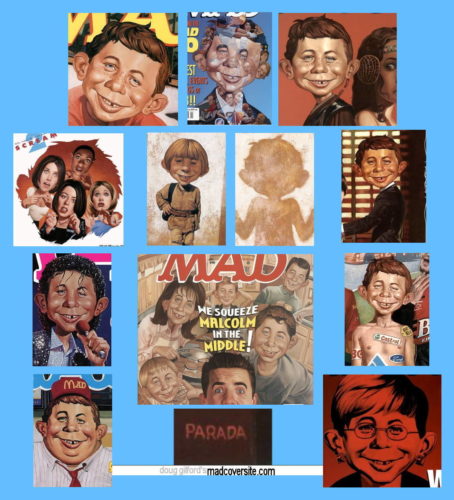
Day 45 – Mark Stutzman
Mark Stutzman’s illustrations have been used in advertising, posters, magazines, book covers and more, including an Elvis Presley stamp, David Blaine event posters, and movie art for Batman and Jurassic Park.

Day 46 – Tom Richmond
Tom Richmond cut his teeth with a chain of caricature franchises in amusement parks before branching out into many national and international publications. Richmond is the first illustrator outside comic books to provide continuity art for MAD’s TV and film parodies in glorious color – a fitting modern reply to the pioneering work of Mort Drucker. In another notable first, Tom provided cover work used in the 2019 success, ‘Once Upon a Time… in Hollywood!’, as suggested by director Quentin Tarantino himself.

Day 47 – Liz Lomax
Some modern covers can have a three-dimensional look, particularly if their likenesses have been based on models sculpted by LIZ LOMAX! An award-winning New York artist who creates hand-sculpted illustrations for ads, mags, newspapers, books and album covers, plus large-scale work for window displays, etc., Liz also creates fine art.
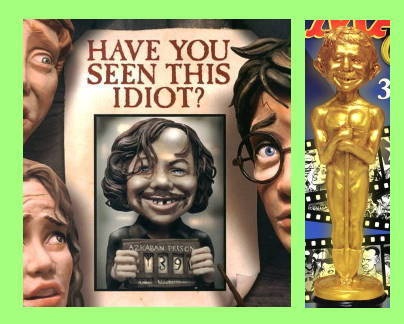
Day 48 – Jason Edmiston
One of the ‘edgier’ MAD cover artists in use since MAD moved east-to-west, JASON EDMISTON’s fondness for pop culture is evident in his sometimes-exaggerated approach to art and humour.
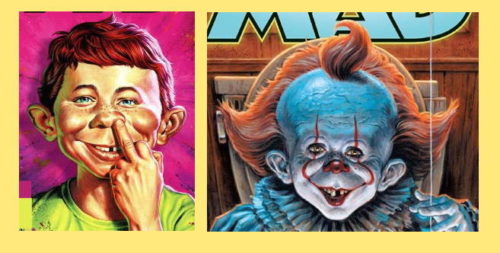
Day 49 – One Shots
This last post contains mainly ‘one-shots’ (although some are guilty of more than one Neuman cover, and more than one art job for MAD). It’s a sobering thought that such luminaries as Frank Frazetta, Boris Vallejo, Dave Gibbons and others are confined to this ‘catch-all’ approach. Some of these make use of the standard ‘office’ version of AEN, but are here for completeness.
This collection of Neuman images in his sundry incarnations would not have been possible without ‘standing on the shoulders of giants’ like Doug Gilford, Mike Slaubaugh the guys who compiled the Totally MAD CD set and, indeed, data available on this, the MAD Trash website.
Best wishes to all Neumanphiles, everywhere.
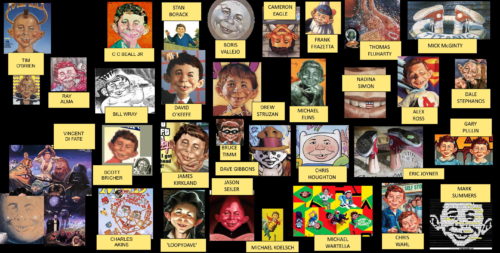
Day 50 – Gap Tooth Gallery
Towards the end of its New York run, the MAD editors ran a short series to offer more general artists – not just comics – an opportunity to show us their version of the eternal cover boy. Participants in ‘The Gap-Toothed Gallery’ included Klaus Voorman, who produced the sleeve art for the Beatles’ Revolver album, and Lego sculptor Nathan Sawaya…
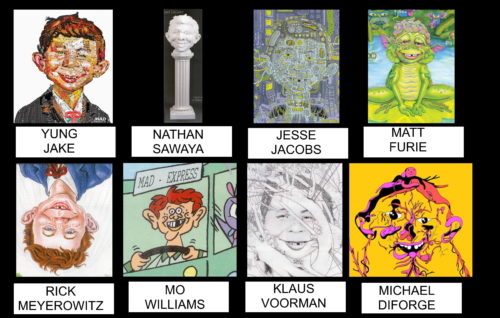
Day 51 – West Coast
With the June 2018 issue, MAD moved dramatically from east coast to west. To call these ‘The New Guys’ is something of a misnomer, but all of these have had Neumans in the new version of MAD. (That mere stripling, Bill Wray, appears in more than one section!)

Day 52 – Tom Bunk
Popular Tomas Bunk rivals Sergio Aragones in the amount of detail he can cram into his larger, idiosyncratic spreads, causing the would-be Neuman-hunter to play ‘Where’s Alfred?’ from issue to issue.
